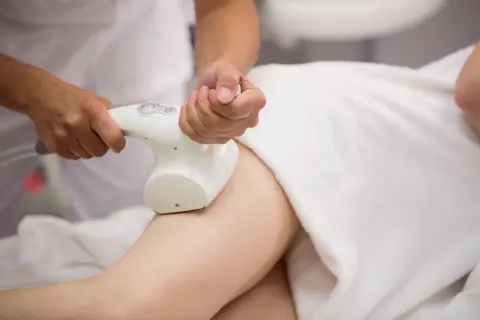Cryolipolysis – Fat Freezing
Cryolipolysis, commonly known as fat freezing, is a non-invasive method of reducing fat in specific areas of the body. This procedure uses a technique that freezes and destroys fat cells without damaging the surrounding tissues. It is a popular alternative to surgical fat removal procedures such as liposuction, and is available in Turkey.
Fat Freezing, also known as Cryolipolysis, is a non-surgical fat reduction treatment that uses controlled cooling to target and freeze fat cells, causing them to die off and be naturally eliminated from the body. This treatment is designed for individuals who are looking to reduce stubborn areas of fat that are resistant to diet and exercise.

During a Fat Freezing treatment, the targeted area is first marked and then a cooling device is applied to the skin. The device then delivers controlled cooling to the underlying fat cells, without damaging the surrounding tissues. The treatment typically lasts around 30-60 minutes, depending on the size of the area being treated.
After the treatment, the frozen fat cells gradually die off and are eliminated from the body through the natural lymphatic system. This process can take several weeks to months, and most patients begin to see results within 2-3 months after their treatment. The number of treatments required varies depending on the individual’s goals and the size of the targeted area.
Fat Freezing is a safe and effective alternative to surgical fat reduction procedures, such as liposuction, as it does not involve any incisions or anesthesia. It is also a relatively painless procedure, with most patients experiencing only mild discomfort or numbness during the treatment.
Some common areas that can be treated with Fat Freezing include the abdomen, love handles, thighs, upper arms, and double chin. However, it is important to note that this treatment is not a weight loss solution and should not be used as a substitute for a healthy diet and exercise routine.
Overall, Fat Freezing is a popular and effective treatment for reducing stubborn areas of fat. If you are considering this treatment, it is important to consult with a qualified healthcare professional to determine if it is right for you.
During a fat freezing treatment, a device is placed on the targeted area of the body. The device then applies controlled cooling to the fat cells, which causes them to freeze and die. Over time, the body naturally eliminates these dead cells, resulting in a reduction in fat in the treated area.
Many people opt for fat freezing as a way to address stubborn pockets of fat that are resistant to diet and exercise. This treatment is commonly used to reduce fat in areas such as the belly, love handles, thighs, and arms.
But does fat freezing work? The answer is yes, fat freezing can be an effective way to reduce fat in targeted areas. However, it’s important to note that this procedure is not a weight loss solution. Fat freezing is designed to reduce fat in specific areas of the body, but it is not a substitute for healthy eating and regular exercise.
Fat freezing is generally considered safe, but there are some risks and side effects to be aware of. The most common side effects include redness, swelling, and bruising in the treated area. These side effects are usually temporary and resolve on their own within a few days or weeks.
There is also a small risk of developing a condition called paradoxical adipose hyperplasia, which is a rare complication where the treated area actually increases in size. This complication is more common in men and is thought to occur in less than 1% of cases.
So, how long does fat freezing last? The results of a fat freezing treatment can be long-lasting, but it’s important to maintain a healthy lifestyle to ensure that the fat does not return. Some people may require multiple treatments to achieve their desired results.
One of the benefits of cryolipolysis is that it is a non-surgical, non-invasive procedure. This means that there is no need for incisions, anesthesia, or recovery time. Patients can typically return to their normal activities immediately after the procedure. This makes fat freezing an attractive option for those who do not want to undergo surgery or who have busy lifestyles.
Another benefit of fat freezing is that it is a targeted treatment. The device used during the procedure can be precisely placed on the area of the body where the patient wants to reduce fat. This means that the surrounding tissues, including skin and muscle, are not affected. The result is a more toned and sculpted appearance in the treated area.
However, it’s important to note that fat freezing is not a quick fix. The results of the procedure are not immediate and can take several weeks or even months to fully develop. It’s also important to maintain a healthy diet and exercise routine to maximize the results of the treatment.
In terms of weight loss, fat freezing is not a solution. While the procedure does eliminate fat cells, it does not address the underlying causes of weight gain. To lose weight, a combination of healthy eating and regular exercise is recommended.
So, what are the risks of fat freezing? While the procedure is generally considered safe, there are some risks and side effects to be aware of. As mentioned earlier, the most common side effects include redness, swelling, and bruising in the treated area. These side effects are usually temporary and resolve on their own within a few days or weeks.
In rare cases, more serious side effects can occur. These can include damage to nerves or blood vessels, changes in skin sensation, or scarring. It’s important to discuss the potential risks and side effects of fat freezing with a qualified healthcare professional before undergoing the procedure.
One common question people have about fat freezing is whether they can lose weight by freezing fat. While the procedure can eliminate fat cells, it is not a weight loss solution. To lose weight, a combination of healthy eating and regular exercise is recommended.
In terms of cost, the price of fat freezing treatments can vary depending on the location and the extent of the treatment. Some clinics may offer package deals for multiple treatments. It’s important to research and compare different providers to find the best option for your needs and budget.

One question that people often ask about cryolipolysis is how long the results last. The procedure can permanently eliminate fat cells in the treated area, but it’s important to maintain a healthy lifestyle to prevent the remaining fat cells from expanding. In other words, while the treated area will have fewer fat cells, it’s still possible to gain weight in other areas if you don’t make healthy lifestyle choices.
Another aspect to consider is the number of treatments needed to achieve the desired results. While some patients may see noticeable improvements after just one session, others may require multiple sessions to achieve their desired outcome. The number of treatments needed depends on several factors, including the patient’s body type, the amount of fat in the treated area, and the patient’s goals.
Fat freezing is not recommended for everyone. It is not a weight loss solution and is not suitable for those who are significantly overweight. The ideal candidate for fat freezing is someone who is close to their ideal weight and has localized areas of fat that are resistant to diet and exercise.
There are several other non-surgical fat reduction procedures on the market, including ultrasound and radiofrequency treatments. These procedures work by heating the fat cells, rather than freezing them. While these treatments can be effective, they may not be suitable for everyone and may not achieve the same level of fat reduction as cryolipolysis.
In addition to Fat Freezing, there are other non-surgical fat reduction treatments available, such as laser lipolysis and ultrasound cavitation. However, Cryolipolysis is considered one of the most effective and safest methods for freezing fat cells.
Cryolipolysis can be used to treat different body types, including those with a high body mass index (BMI). However, individuals with certain medical conditions, such as cryoglobulinemia, cold agglutinin disease, or paroxysmal cold hemoglobinuria, should not undergo this treatment.
When considering Fat Freezing or any other fat reduction treatment, it is important to have realistic expectations and understand that results may vary from person to person. It is also important to choose a qualified healthcare provider with experience in the specific treatment being considered.
Possible side effects of Fat Freezing may include temporary numbness, redness, swelling, or bruising in the treated area. These effects typically subside within a few days to weeks after the treatment.
Cryolipolysis is sometimes referred to as “freeze fat,” “freezing fat,” or “fat sculpting.” It is also known as “cryo body sculpting” or “cryo fat freezing.” These terms all describe the same non-surgical fat reduction treatment.
Fat Freezing can be particularly effective in reducing belly fat, which is a common area of concern for many individuals. It is also a popular treatment for reducing love handles and double chins.
Some individuals may be interested in “freezing fat off” in order to avoid surgical procedures like liposuction. Fat Freezing offers a non-invasive alternative to liposuction that does not require anesthesia or incisions.
Overall, Cryolipolysis is a safe and effective treatment for reducing stubborn areas of fat. While it may not be suitable for everyone, it is a popular option for individuals looking to achieve their desired body shape without undergoing surgery. If you are considering Fat Freezing, be sure to consult with a qualified healthcare provider to determine if it is right for you.
Fat Freezing works by targeting and freezing fat cells, causing them to crystallize and die off. This process is also sometimes referred to as “freezing fat cells” or “freeze fat away.”
The frozen fat cells are then naturally eliminated from the body over time through the lymphatic system. This process is sometimes called “freezing fat cells out” or “eliminating fat cells by freezing.”
The results of Fat Freezing are long-lasting, as the treated fat cells are permanently destroyed and cannot return. However, it is still important to maintain a healthy lifestyle, as remaining fat cells in the body can still expand with weight gain.
While Fat Freezing is generally considered safe, some individuals may experience side effects such as temporary numbness, tingling, or discomfort in the treated area. These effects are typically mild and go away on their own within a few days to weeks after the treatment.
In summary, Fat Freezing is a safe and effective non-surgical fat reduction treatment that can help individuals achieve their desired body shape. By targeting and freezing fat cells, this treatment offers a permanent solution to stubborn areas of fat. If you are interested in Fat Freezing, be sure to consult with a qualified healthcare provider in Turkey, including in İstanbul, to determine if it is right for you.
